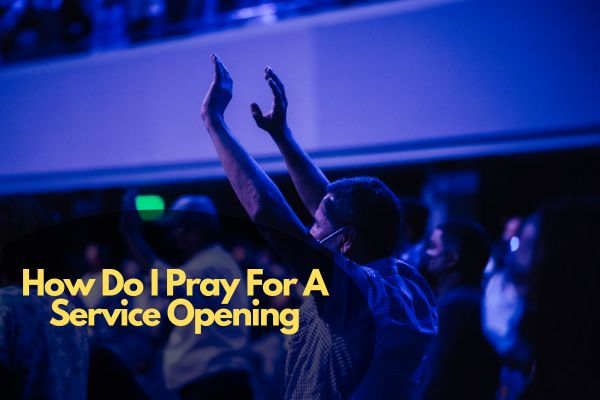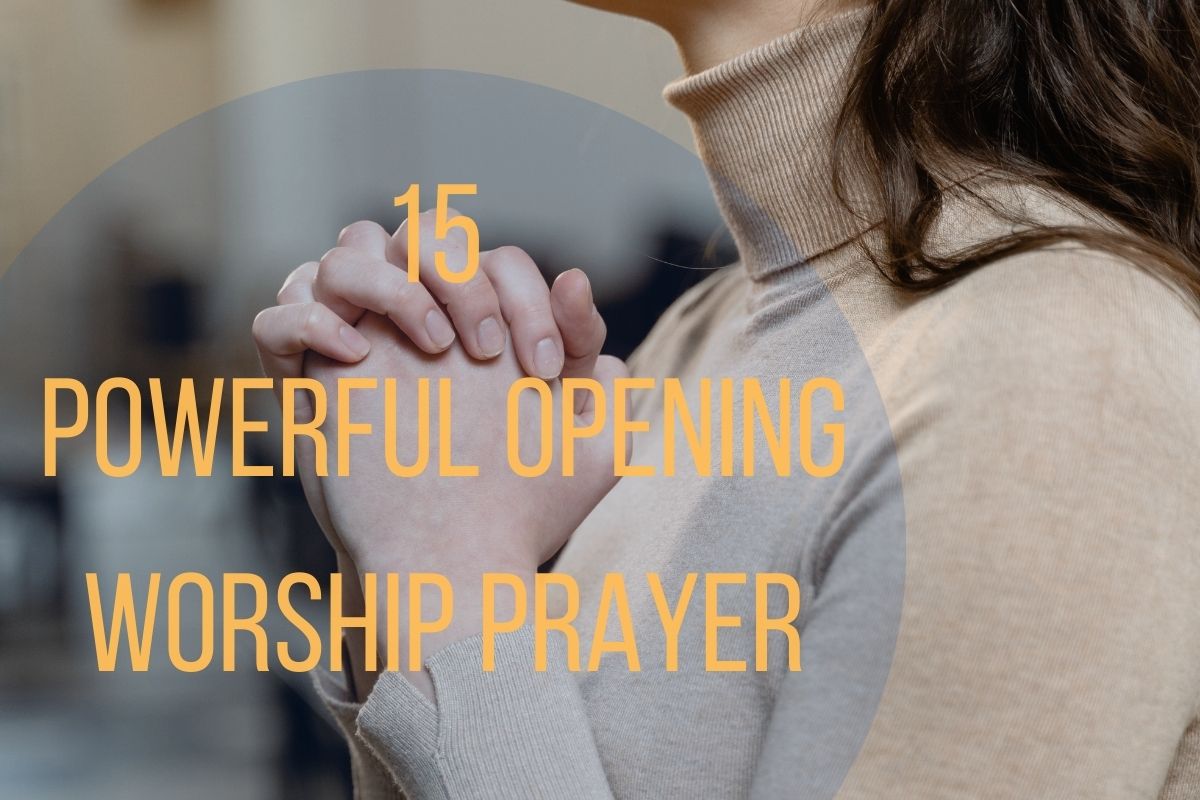Prayer is a deeply personal and spiritual practice that serves as a bridge between the finite human experience and the infinite divine presence. It is a means of communication, reflection, and communion with God. Opening prayers, in particular, are significant in setting the tone for a variety of gatherings, events, and, most importantly, personal moments of devotion.
1. How To Pray An Opening Prayer
Opening prayers are not mere formalities; they hold a profound significance. They serve as a way to invite God’s presence, wisdom, and guidance into a situation or event. Whether you’re starting a meeting, embarking on a journey, or simply seeking a spiritual connection, an opening prayer can provide a sense of reverence and purpose.
Praying an opening prayer is a common practice in many religious and spiritual traditions. It’s a way to invoke divine guidance, set the tone for a gathering or event, and express gratitude or intention. The specific words and format of an opening prayer can vary widely depending on your faith and the context, but here’s a general guide that you can adapt to your beliefs:
Find a Quiet and Reverent Space
Choose a quiet and comfortable place where you can focus on your prayer without distractions. This could be a place of worship, your home, or any peaceful location.
Prepare Your Heart and Mind
Take a few moments to center yourself and clear your mind. You can sit or kneel, close your eyes, and take a few deep breaths to calm yourself.
Begin with Gratitude
Start your opening prayer by expressing gratitude. You can thank the Divine, God, or the Higher Power for the opportunity to pray and for the blessings in your life. This sets a positive and humble tone.
Address the Divine
Address the Divine in a way that is meaningful to your faith. For example, you might say, “Dear God,” “Heavenly Father,” “Creator,” or another appropriate title.
State Your Purpose
Clearly state the purpose of your prayer. Whether it’s for guidance, strength, protection, or any other intention, make your request known to the Divine.
Ask for Blessings
Ask for blessings, assistance, or guidance related to your purpose. Be specific about what you’re seeking. For example, if you’re praying for a family gathering, you might ask for unity, love, and a joyful time together.
Seek Forgiveness
If you feel the need, ask for forgiveness for any wrongdoings or mistakes you may have made. This can help cleanse your heart and make you feel more open to the Divine.
Pray for Others
Consider including prayers for other people, such as friends, family, or those in need. Intercessory prayers can be a powerful way to show compassion and empathy.
Close the Prayer
As you conclude your opening prayer, you can do so with a closing statement such as “In [Divine name]’s name, I pray,” or another closing that is meaningful to your faith.
Amen
Many people end their prayers with “Amen,” which is a common way to affirm the prayer’s sincerity and signify that it is finished.
Remember, an opening prayer can be as formal or informal as your faith and the situation require. It’s a deeply personal practice, and you can use your own words and feelings to connect with the Divine. The key is sincerity and a humble heart.
2. Preparing Your Heart and Mind
Before uttering an opening prayer, it’s essential to prepare your heart and mind. Find a quiet space where you can focus and connect with the divine. Take a moment to center yourself, leaving behind distractions and worries. In these moments of quiet reflection, you create a receptive space for God’s presence.
3. Choosing the Right Setting
The setting for your opening prayer matters. It can be as simple as a quiet corner of your home, a peaceful garden, or even a designated place of worship. The setting should be free from disruptions, allowing you to concentrate fully on your communion with God.
4. Opening Prayer Format
The format of an opening prayer can vary depending on the context and the individual or group leading the prayer. However, there are some common elements that are often included in an opening prayer. Here’s a general format you can follow:
Address to a Higher Power: Begin by addressing the divine or higher power to whom the prayer is directed. This could be a simple “Dear God,” “Heavenly Father,” “Lord,” or any other appropriate title or name based on your religious or spiritual tradition.
Gratitude: Express gratitude for the opportunity to come together in prayer or for the blessings and opportunities in life. This can set a positive and thankful tone for the prayer.
Invocation: Invite the divine presence or spirit to be with you and those participating in the prayer. You can ask for guidance, strength, or support as needed.
Intent or Purpose: Clearly state the purpose of the prayer. Whether it’s for a specific event, gathering, or simply to seek spiritual connection and guidance, make your intentions known.
Personal or Group Needs: Include personal or collective requests or needs, such as blessings for the participants, healing for the sick, wisdom for decision-makers, or comfort for those in distress.
Acknowledgment of Humanity: Recognize human limitations and ask for forgiveness for any shortcomings or mistakes. This can be a moment of self-reflection and humility.
Closing: Conclude the prayer with a closing statement or phrase. This can include a traditional closing, such as “Amen” (common in many Christian traditions), or another suitable phrase from your specific religious or spiritual tradition.
Silence: Allow a moment of silence for personal reflection or for others to add their personal prayers, if it’s a group setting.
Remember that the format of an opening prayer can vary widely across different religious and cultural traditions. It’s important to be respectful of the beliefs and practices of those you are praying with, and adapt the format accordingly. Personalize the prayer as needed, and use language and terminology that are meaningful to you and your audience.
5. Addressing God Reverently
Begin by addressing God with reverence, acknowledging His greatness, and the privilege of coming before Him in prayer.
Expressing Gratitude
Express gratitude for the opportunity to pray and for the blessings in your life. Gratitude sets a positive tone for your prayer.
Seeking Guidance
Request God’s guidance and wisdom in the matter at hand. Seek His will and direction in your actions or decisions.
Interceding for Others
Intercede on behalf of others, lifting their needs and concerns to God. Praying for the welfare of others reflects compassion and empathy.
Closing with Amen
Conclude your prayer with “Amen,” which signifies agreement and a seal of your prayer. It’s a way to express your trust in God’s response.
6. Practical Tips for Effective Opening Prayers
1. Keep it simple and sincere.
2. Use clear and understandable language.
3. Speak from the heart.
4. Maintain a conversational tone.
5. Be mindful of the occasion and audience.
7. The Power of Personal Connection
Your opening prayer can be a deeply personal moment of connection with God. It’s not just a ritual; it’s an opportunity to establish a personal relationship with the divine. Let your prayer be an authentic expression of your faith and your unique connection with God.
8. Examples of Opening Prayers
For those new to opening prayers, examples can be incredibly helpful. They provide insight into the structure, tone, and content of a well-crafted prayer. Here are two examples:
1. Opening Prayer for a Family Gathering
“Heavenly Father, we gather as a family with grateful hearts. We seek Your presence and guidance as we come together. Bless our time with love, joy, and unity. In Jesus’ name, we pray. Amen.”
2. Opening Prayer for Personal Devotion
“Dear Lord, as I begin my day, I open my heart to You. Grant me wisdom, courage, and strength to face the challenges ahead. Thank You for Your unwavering presence in my life. In Your name, I pray. Amen.”
9. Bible Verses on Prayer
The Bible is a rich source of guidance on prayer. Here are a few verses to reflect on:
James 5:16 (NIV)
“The prayer of a righteous person is powerful and effective.”
Philippians 4:6 (NIV)
“Do not be anxious about anything, but in every situation, by prayer and petition, with thanksgiving, present your requests to God.”
10. The Lord’s Prayer: A Model for All
The Lord’s Prayer, as taught by Jesus, is a profound model for all prayers. It covers essential elements of prayer, including adoration, supplication, and forgiveness. Using this prayer as a template can provide structure and depth to your opening prayers.
The Lord’s Prayer, also known as the Our Father, is one of the most universally recognized and recited prayers in the Christian faith. It holds a special place in the hearts of believers across denominations and has transcended its religious boundaries to become a model for prayer and a source of inspiration for people of various backgrounds. This simple yet profound prayer, given by Jesus to his disciples, offers a template for all humanity, regardless of their religious affiliation, to approach the divine, seek guidance, and find a path to a meaningful and purposeful life.
A Universal Connection: The Lord’s Prayer begins with the words, “Our Father,” emphasizing a universal connection between all human beings and a higher power. It is an invitation for everyone to recognize their divine connection, fostering a sense of oneness among people, transcending religious and cultural divides.
The Sanctification of God’s Name: The prayer continues with “hallowed be thy name.” This phrase encourages us to acknowledge and respect the sacred, the divine, and the profound in the world, reminding us of the importance of reverence and awe in our lives.
Seeking Divine Will: The prayer encourages us to pray for God’s will to be done on Earth as it is in Heaven. This is a powerful reminder of the importance of aligning our desires and intentions with a greater purpose, promoting a sense of righteousness, harmony, and justice.
Daily Sustenance: “Give us this day our daily bread” speaks to our fundamental human needs. It serves as a reminder that we should not only seek spiritual nourishment but also ensure that the physical needs of all individuals are met, emphasizing empathy and care for one another.
Forgiveness and Reconciliation: “Forgive us our trespasses as we forgive those who trespass against us” underscores the transformative power of forgiveness. It encourages us to reflect on our own actions and relationships, emphasizing the importance of reconciliation and forgiveness in our lives.
Guidance and Protection: “Lead us not into temptation but deliver us from evil” is a plea for guidance and protection. It recognizes the human propensity to stray from the right path and emphasizes our need for divine support to make ethical and moral choices.
An Affirmation of Faith: The Lord’s Prayer ends with the phrase “For thine is the kingdom, the power, and the glory, forever and ever.” This serves as an affirmation of faith, acknowledging the eternal nature of the divine and our trust in its overarching presence.
The Lord’s Prayer transcends religious boundaries and provides a model for how individuals can approach their spirituality and seek guidance from a higher power. It promotes values such as unity, reverence, justice, compassion, forgiveness, and faith, which are universally applicable and essential to the human experience.
Even for those who do not identify with Christianity, the Lord’s Prayer can be a source of inspiration and reflection. Its universal themes and values provide a blueprint for leading a life filled with purpose, meaning, and a deep connection with the transcendent. In a world marked by diversity, this prayer offers a model for all to embrace a common humanity, regardless of their individual beliefs or backgrounds.
Conclusion
Praying an opening prayer is not a matter of formality but a powerful way to invite God’s presence, guidance, and blessings into your life. It’s an act of faith, humility, and connection with the divine. Whether in a public gathering or in the quiet of your home, may your opening prayers be moments of genuine connection with God.
FAQs
1. What is the purpose of an opening prayer?
An opening prayer serves to invite God’s presence and guidance into a situation, event, or personal moment of devotion.
2. How can I make my opening prayer more personal?
Make it a conversation with God, speak from the heart, and express your own thoughts and feelings.
3. Are there specific words or phrases I should use in an opening prayer?
There are no specific words or phrases required. Keep it simple, sincere, and clear.







